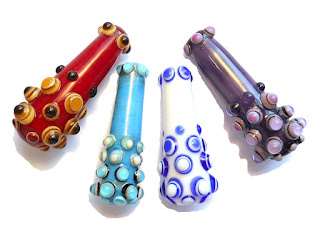Well, I recently purchased a pair of amazing glass beads with musical notes on a staff from
Heather Behrendt. The stringer work on them was so precise and tiny I could hardly believe my eyes. Needless to say, I started thinking that it was maybe just slightly possible that I could begin to learn to draw a few lines on some beads. I know the theory, of course~ pull very fine stringer, find sweet spot in flame, apply to bead. Sounds easy, yes? Oh! I forgot something~ p,p,p (practice, practice, practice, in case you had something else in mind).

I tried a wee bit of this out yesterday, and here are a few conclusions, ideas and points of interest. Firstly, if you are just scribbling stringer randomly around a bead, you can heat up a pea-sized bit of glass on the end of a rod to a nice red glow, pull it out of the flame, attach it to the bead and run it quickly around the bead by either turning the bead around or moving the blob about. This is what I call a 'glass blowers style' application as was used in this bead. Not a teeny tiny line, but quite easy to do, and no need to pull stringer in advance as you are using a blob of glass instead of a thin bit.

But anyone can do that, right? Time to move on to something a bit more difficult. The next bead was made using a commercial thin stringer. Thinner than a regular commercial stringer, but still not really thin, so the lines still ended up thick-ish. I tried out a couple of parallel lines and then a couple intersecting lines. Here's where the sweet spot in the flame came into play. I have often heard that you can work to the side of the flame, using the heat of the bead to heat the stringer. Seems I was working more in front of the flame. I don't think it really matters, as long as the bead is hot enough to make the stringer stick. The stringer should be applied by pushing it onto the bead, not just laying it down onto the bead, or it will not adhere properly. If that happens, it will pull off of the bead and ball up, giving you dots instead of lines. In this case, I added some dots at the intersections of the lines to help hide any blobby bits there.


Now on to the harder stuff! For this bead, the first step was pulling some thin stringer. I have not gotten to the hair-thin phase, but it's pretty thin! I decided to try some colors other than black just for fun. The main tip here is- PAY ATTENTION! Hold the stringer near the end so it doesn't wobble while you apply it, but be sure there is enough sticking out to make the entire swipe onto the bead at once. Be sure the tip of your stinger is not blobbly (cut it off if it is), heat the bead, put it in position out of the flame, but still close (your sweet spot) and apply the stringer by pushing it onto the bead. Wow, do I have shaky hands! You can see I used a lot of dots here and there to hide ends and wobbly bits. I had to figure out how to make that a design element! Oh, but now I've given it away... I do like the look of the different stringer colors~ helps with the retro look! And you can see that is is very different on each side. Why the heck not?!
I will have to let you know if the p,p,p works out, or if I just end up peeved, peeved, peeved!























